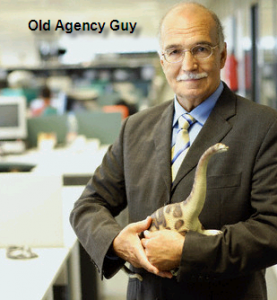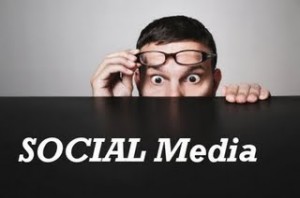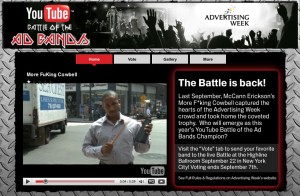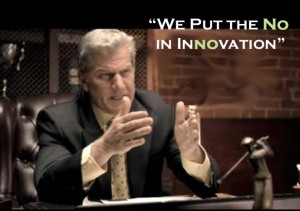Pay attention now, online-video and advertising peeps. This lil’ blog post is going to be on the final exam. It might even spawn a trade article and a new business.
-

Search engine marketing (SEM) is big business today, with agencies charging retainers to help websites rank high on search engines (increasing qualified traffic) and help manage paid advertising. Paid search (text ads on Google, Yahoo and MSN) already is annually around a
$10 billion industry. Maybe more, maybe less.
- Online video will likely be a billion plus industryin 2009 and growing at a rate of between 50-70 percent annually for the foreseeable future (see roundup of online-video industry projections).
Would you like Uncle Nalts to tell you where the gold is in ‘dem hills?
Kay, first let’s get into our time machine and go back 7-8 years. Around 2000, Nalts got nervous about the impending bubble burst and took shelter with Big 5 Consulting (KPMG). Turns out the Big 5 was no better poised than Internet marketing agencies and eventually Nalts would camp-out on client side so he could see his kids grow up. But that’s besides the point. Nalts got some good training on consultative selling and how to solve problems for C-level (that’s CEO, CIO, CFO) folks. Seems the VITO (very important top executive) loses sleep sometimes, and if you can help him/her sleep better they don’t mind giving you money. They sleep better when they can measure a marketing spend especially in a tight economy.
 But I’m getting ahead of myself… before Uncle Nalts left his interactive agency (Qwest), he pitched The Big Guy on building a paid-search practice. Brand teams were happy to spend $300-$500 thousand dollars on a big ass website, but it was equally important getting customers to actually visit those big-ass websites. Eventually the interactive agencies figured this out, but not before screwing it up with big-mouth idiots who promised to handle paid-search campaigns like “day traders”… and then ran off to the next pitch and left the campaign unoptimized and in autopilot. I can smell these people before they enter our building.
But I’m getting ahead of myself… before Uncle Nalts left his interactive agency (Qwest), he pitched The Big Guy on building a paid-search practice. Brand teams were happy to spend $300-$500 thousand dollars on a big ass website, but it was equally important getting customers to actually visit those big-ass websites. Eventually the interactive agencies figured this out, but not before screwing it up with big-mouth idiots who promised to handle paid-search campaigns like “day traders”… and then ran off to the next pitch and left the campaign unoptimized and in autopilot. I can smell these people before they enter our building.
Even today agencies suck at SEM with a few exceptions, and most acquired their way there. Of course as a Product Director, I’m reluctant to hire a specialist SEM firm because they’ll only get into a pissing war with my interactive agency and media buyer. My peers at other companies consolidate paid-search spending even though the media spend is bid-based (so you don’t exactly garner spending/scale efficiencies except on campaign and analytic fees). So I hire an independent consultant to fill giant gap between my brand team, internal groups (promotions/Internet), agencies and analytics.
The best way to predict *some* of video’s future is to look at the past.Online video will follow the route of the SEM field in 2008-2011. Sure other things will grow and die along the way (from Hulu and eFoof to Revver and Vloggerheads).
But trust me that online video will eventually be managed the way we manage all other promotional content and media:
- Brands spend a fortune telling their story and making persuasive content (and sometimes even serve customers along the way). This stuff will become less important with time unless it is engaging and, dare I say, entertaining.
- We work like hell to get high organic (unpaid) placements on The Orb called Google- that means optimizing our content and getting it distributed on credible third parties. In video, of course, this translates to tagging, seeding, moving quickly, and leveraging popular amateurs– even little Uncle Nalts gets about 1.6 MM uniques per month on his videos.
- Finally, we buy ads on Google for relevant keywords- I’ll speak for myself but there’s NO OTHER SPEND that’s directly as measurable as paid search. It’s bending over the rest of the marketing mix and has it squeeling like a pig. Its only weakness is scale, but I like the pay-for-performance accountability.
Now Uncle Nalts was going to hoard these powerful insights, but he’s sharing them here on his blog for the low, low price of nothing. Nalts will even confess that this is the space in which he wants to play (not marketing drugs until he retires).
You gotta do what you love, which for me is entertaining and marketing via emerging media. How fun to help brands get their good content seen via existing video sites and search engines, then supplant that “organic” play with targeted advertising buys (ideally at a cost-per-click and keyword targeting level). Okay it doesn’t sound as fun as blowing bubbles or eating Captain Crunch, but it’s fun to me. And if the video content sucks, then let’s create new videos without exhaustive, bloated production shoots. Even more good news: you don’t have to spend $250K MM on YouTube to get paid (promoted) views.
If you’re interested in financing a startup around this, just send me cash. I think I need about $500K, but no pesky venture capitalists please. You VCs creep me out, even if you’re still investing in video like drunken sailers.
Honestly, here’s why I don’t mind sharing this powerful insight (which some of you will find obvious now that I’ve said it, and others will be only mildly amused because the significance is lost on them). Because few are poised to tackle this issue yet. How many have experience with the mix of marketing, Internet advertising, and video? And the magic is in the implementation unless you’re the fat, smelly guy who pitches “SEM dashboard” full time.
 The agencies will make a mess of this. I think it goes without saying that large full-serve “integrated” agencies (don’t laugh when I say integrated please) will wait until 2012 until they trip over this space by accident. Picture the dinosaurs that used to chew their tails raw before they even felt the pain.
The agencies will make a mess of this. I think it goes without saying that large full-serve “integrated” agencies (don’t laugh when I say integrated please) will wait until 2012 until they trip over this space by accident. Picture the dinosaurs that used to chew their tails raw before they even felt the pain.
Even the interactive agencies will make a mess of it. Remember when the interactive firms tried to get into paid search and search engine marketing in the early 2000’s? It was embarassing. And most interactive agency people don’t know online video, much less know what a social media and online-video marketing plan might look like. Heck a woman at an agency last week told me she hadn’t heard of Twitter (but YouTube sounded familiar). And of course information management is still using terms like “portal” while PR firms spew about “blog and social media strategy,” and wouldn’t know a viral video if it urinated on their leg or licked them on the face.
While the agencies are ignoring it or screwing it up, a few bright people will build up an offering that helps brands place content organically (and seed it), and conduct efficient media spends to promote the content. Again- I think the magical stool has three legs: marketing, digital advertising and online video. Yeah- like my old Drunk Uncle Jim used to say- when there’s a gold rush, sell shovels.
After all… it’s hard to sleep when your videos, like $500K bad-ass websites, are “billboards in the back yard.”













